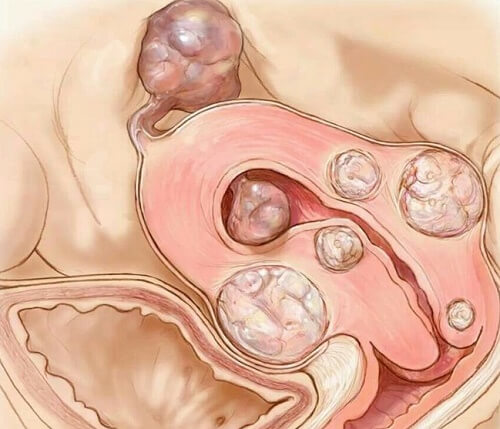5 Facts About Uterine Fibroids That Every Woman Should Know

Uterine fibroids are abnormal masses of muscular tissue that form on the surface of the uterus, and rarely, on the cervix.
Their presence tends to cause alarm, but only 0.5% develop into carcinogenic cells.
This means that, although they cause discomfort, they rarely represent a cancer risk.
However, it’s a condition that requires a lot of attention, since it can interfere with reproductive and hormonal health.
The Spanish Society of Gynecology and Obstetrics (SEGO) assures that nearly 70% of women can have this problem at some point in their lives.
In spite of this, women don’t inform themselves well enough about this issue and tend to learn about this disease later on in life.
For this reason, we would like to share 5 relevant facts that every woman should know about uterine fibroid development.
Take time to get to know them!
1. What is a Uterine Fibroid?

Uterine fibroids are benign tumors that tend to appear after 20 years of age.
Also known as leiomyomas or fibromyomas, they are small, round masses of tissue whose size ranges from microscopic to very huge.
Its appearance is related to genetic and hormonal factors and unfortunately is a cause for infertility in women.
Read More: 7 “Innocent” Habits that Cause Hormonal Imbalances
2. What Types of Uterine Fibroids Exist?
There are four types of fibroids, depending on their location in the uterus.
Sub Mucosal Fibroids
- These are formed just below the myometrium, the layer that protects the interior wall of the uterus.
- It can extend into the internal cavity of the uterus, and as it grows, it tends to occupy a large part of it.
Subserosal Fibroids
- This type of mass forms just beneath the serous membrane, a layer that covers the external part of the uterus.
- Its appearance makes the uterus have a nodular aspect.
Pedunculated Fibroid
- These fibroids are a sub-serous type. However, unlike the previously mentioned type, they grow and end up detaching from the uterus, held by a fine looking strand known as a pedicle.
- This type of tumor can grow into the uterine cavity or out of it.
Intramural Fibroids
- These are masses that form within the muscular wall of the uterus. When enlarged, they can distort both the exterior and internal wall.
3. What Are the Symptoms Of Uterine Fibroids?

Although there are many cases where there are no symptoms, hence making it difficult to diagnose, more than half of those affected by them can experience changes that can hint their presence.
Among the most common symptoms are:
- Abundant and irregular menstrual bleeding
- Inflammation and pain in the lower abdomen
- Sudden weight gain
- Difficulty getting pregnant
- High-risk pregnancies and births
- Painful intercourse
- Changes in urine habits
- Backaches
4. How do Uterine Fibroids Affect Fertility?
One of the main worries among women diagnosed with this condition are the consequences that lead to an affected reproductive health.
When the tumors reach a significant size, it’s probable that fertility can be affected or complicate pregnancy.
The risk of becoming infertile varies with each case, almost always depending on the amount of fibroids, their size and location in the uterus.
The fibroids increase in size with high estrogen levels. Since progesterone is abundant during pregnancy, it is possible during this time to perform a fertility treatment.
However, you have to bear in mind that its presence increases the risk of abortion during the first trimester of gestation and can cause early labor when getting close to the end of pregnancy.
For now, myomectomy is one of the most valid options for those in reproductive age to try if pregnancy is a nearby goal.
Read More: How to Increase Fertility
5. What Are the Treatments Available for Uterine Fibroids?

Many of the woman who are diagnosed with this condition think that only solution to fight fibroids is through surgical intervention.
However, it’s important for you to know that surgery isn’t the only solution. Plus, when the fibriods are very small, it’s not even necessary.
Generally, small masses are treated with a pharmacological treatment prescribed by a doctor.
If these don’t respond to the medication and increase in size, there isn’t another option than to remove them.
In these cases, a myomectomy is performed, which focuses on the elimination of fibroids without affecting the uterus. When there are complications, a hysterectomy is performed, which removes the uterus in part or wholly.
Many specialists recommend an ulipristal acetate treatment, a progesterone modulator that reduces the presence of these tumors in the uterus.
In conclusion, paying attention to the symptoms and continuous gynecologic revisions are crucial to accomplish an opportune diagnosis of this disease.
Although most of the time it isn’t serious, it’s always convenient to consult a doctor to examine you carefully.
All cited sources were thoroughly reviewed by our team to ensure their quality, reliability, currency, and validity. The bibliography of this article was considered reliable and of academic or scientific accuracy.
- Hurst, B. S. (2014). Uterine fibroids. In Ultrasound Imaging in Reproductive Medicine: Advances in Infertility Work-Up, Treatment, and Art. https://doi.org/10.1007/978-1-4614-9182-8_10
- Khan, A. T., Shehmar, M., & Gupta, J. K. (2014). Uterine fibroids: Current perspectives. International Journal of Women’s Health. https://doi.org/10.2147/IJWH.S51083
- Zimmermann, A., Bernuit, D., Gerlinger, C., Schaefers, M., & Geppert, K. (2012). Prevalence, symptoms and management of uterine fibroids: An international internet-based survey of 21,746 women. BMC Women’s Health. https://doi.org/10.1186/1472-6874-12-6
- Pavanello, L., Cesari, S., Biasiutti, C., Manfredi, R., & Pozzi Mucelli, R. (2015). Fibroids. In MRI of the Female and Male Pelvis. https://doi.org/10.1007/978-3-319-09659-9_5
- Marret, H., Fritel, X., Ouldamer, L., Bendifallah, S., Brun, J. L., De Jesus, I., … Fernandez, H. (2012). Therapeutic management of uterine fibroid tumors: Updated French guidelines. European Journal of Obstetrics Gynecology and Reproductive Biology. https://doi.org/10.1016/j.ejogrb.2012.07.030
This text is provided for informational purposes only and does not replace consultation with a professional. If in doubt, consult your specialist.








